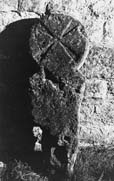Select a site alphabetically from the choices shown in the box below. Alternatively, browse sculptural examples using the Forward/Back buttons.
Chapters for this volume, along with copies of original in-text images, are available here.
Object type: Grave-marker
Measurements: H. 85 cm (33.5 in); W. disc head 31 cm (12.25 in); shaft 28 > 23 cm (11 > 9 in); D. disc head 12 cm (4.75 in); shaft 15 cm (6 in)
Stone type: [Tealby Limestone, Lower Cretaceous of Lincolnshire]
Plate numbers in printed volume: Ill. 396
Corpus volume reference: Vol 5 p. 277-278
(There may be more views or larger images available for this item. Click on the thumbnail image to view.)
A disc-headed marker with shouldered and tapering base, the greater part of which is only roughly dressed and clearly intended to be earthfast.
A and C (broad): The disc head has a neatly chamfered arris to both faces. One broad face is decorated in low relief with a cross of type E6.
B, D and E (narrow sides and top): Undecorated except for the chamfer on the head.
Appendix A item (stones dating from Saxo-Norman overlap period or of uncertain date).
This is a marker type of common occurrence in Lincolnshire. Close parallels though with slightly different cross types exist locally at Beelsby 1 and 2 (Ills. 392, 394). The type is found in significant numbers in north-east England, with examples of closely similar cross form at Newcastle-upon-Tyne 1 (Cramp 1984, pls. 248, 1371 and 249, 1376), Norham 18 (ibid., pl. 248, 1374), Warkworth 3 (ibid., pl. 255, 1396), and Woodhorn 3 (ibid., pls. 257, 1401 and 258, 1403), all Northumberland, and there taken to date to the late eleventh century. The Newcastle piece has an archaeological context of reuse before 1178. In the Lincolnshire context, the stone type suggests a post-Conquest date.
Cross pattée examples of this form of marker are listed in Appendix F [separate PDF]. They include a second marker from Cabourne indistinguishable from Cabourne 1 except for its cross type. The two may probably have stood as a pair in a single complex monument or grave suite. This throws doubt on there being any clear chronological distinction between the cross types. Very similar examples to the second Cabourne marker have also been included in earlier Corpus volumes, as at Birtley 4 (Cramp 1984, pl. 234, 1325–7) or with a central roundel at Heddon-on-the-Wall 1 (ibid., pl. 237, 1342–3) both Northumberland, and there taken to date to the late eleventh century.



